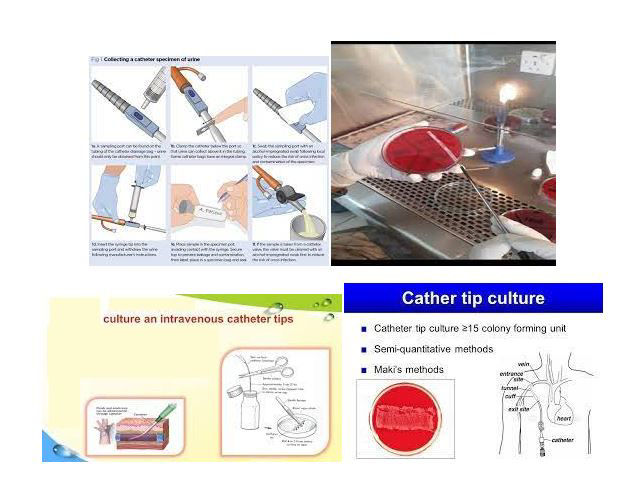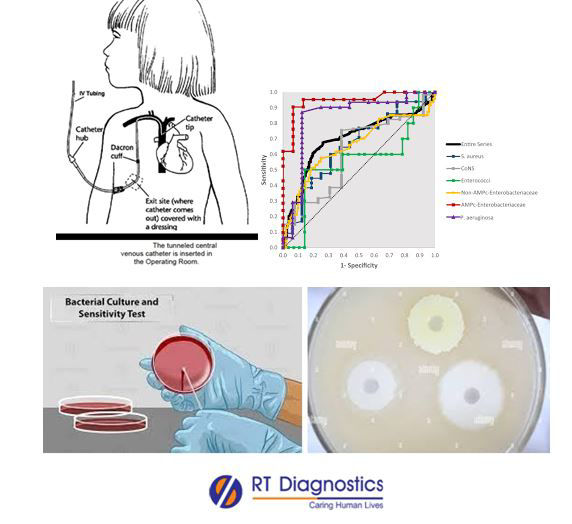Culture & Sensitivity - Catheter Tip
The catheter is a thin plastic tube that is inserted into the surface of the body part (as guided by the physician), to obtain the sample specimen - At the site of the injected part (in case of suspected infection) like catheter (site of prick or insertion of venflon, etc). This test is used to detect the infection caused by harmful microorganisms eg. Pathogens like Bacteria, fungi, etc. Culture & Sensitivity test (performed in the laboratory to examine for any microbial growth in the given sample specimen such as blood, urine, CSF, etc) in the blood/urine is done that helps to investigate for any growth of foreign pathogens (external microbes) like bacteria and other microorganisms present in the blood (any given sample specimen). Hence this laboratory test is ordered as a key test to detect any infection in suspected pathologies like fever – eg. Fever of unknown origin (related clinical manifestation).
Culture & Sensitivity: Catheter Tip:
Why Culture and Sensitivity (Catheter Tip) Test?
CLINICAL INFORMATION
The catheter is a thin plastic tube inserted into the body during any invasive procedures such as surgery for example urinary catheter, venflon, etc. Cannula can become colonized with bacteria (especially by the skin flora ie. Causing opportunistic infection in an immune-compromised patient like HIV/ AIDS or patient receiving immunosuppressive drug therapy), that may invade through the bloodstream and can cause systemic infection. Indwelling catheters are used extensively for both monitoring and intervention in clinical treatment. The vast majority are peripheral lines, central venous, arterial catheters, etc are also used. Other lines include venflon, CVP line, subclavian line, internal jugular line, Hickman line, PICC line, TPN line, pacing and pacemaker wires, etc. Intravascular devices related bacteremia is a significant clinical problem in hospitals since it is an important source of nosocomial infection (Hospital borne infection with resistant strains to medications). Vascular line tips for the investigation of potential or proven bacteremia should only be sent along with a blood culture. Indications for this Culture and sensitivity (Catheter tip) test are inflamed site at the site of prick and/insertion of any catheters, unexplained fever with a central line in situ, etc. Culture and sensitivity (Catheter tip) test primarily aim at analyzing, for any incidence caused by some infectious microbes inside the body (mainly aerobic microorganisms present at the catheter tip eg. mycobacterium, yeast, etc) that manifests with clinical signs and symptoms of an infection. Clinical manifestations include chills, fever, fatigue, nausea, confusion, increased heart rate, nasal flare due to increased breathing -which may or may not be associated with shortness of breath on physical exertion, inflammation (presenting with cardinal signs of inflammation like – rubor, tumor, calor, dolor and loss of function), blood clots, drop in blood pressure, organ failure, elevated WBCs, etc. This test includes a semi-quantitative culture via the Maki method, ie. Isolation and identification of microorganisms with greater than 15 colonies, and susceptibility testing, etc. The suspected catheter tip of the patient is rolled over across an agar plate and checked for microbial growth. If the test result shows the presence of more than (≥15) colonies along with the same organism isolated from peripheral blood along with clinical signs and symptoms, then the case is said to be an infected positive case from the site of contaminated catheter tip/infected area (at the site of insertion). Other isolated organisms eg. yeast, mycobacterium, etc, apart from pathogenic aerobic microbes can be ordered or may be referred for identification of certainly suspected micro-organism(s) and/or furthermore the specimen may also be subjected to sensitivity tests -susceptibility testing if medically indicated. Once tested positive additional tests are ordered for evidence-based therapy such as CBC, gram stain, test for the presence of bacterial toxins (release of toxic by-products) eg staphylococcal infection eg. in case of foodborne-illness/food poison (or their toxins), different sample specimen collected for tests eg. blood, stool, urine culture, sputum test, CSF sampling, ascetic fluid, pleural fluid, pericardial fluid, synovial fluid, complement test (to check for increased levels of C3), etc and moreover sensitivity test (also known as susceptibility testing) are also performed in addition, for appropriate antibiotic treatment & for better prognosis eg. MRSA- methicillin-resistant Staphylococcus aureus, VMSA – vancomycin-resistant Staphylococcus aureus, etc.


General Instructions:
Sample Requirement: Specimen - Blood sample collected from the vein. Test Preparation: None.
NOTE - Sample for specimen collections may vary based on the patient’s condition/cases according to the patient’s presenting complaints/signs or symptoms:
SPECIMEN REQUIREMENT (Special or Rare Cases) - As instructed and guided by Physician / Clinician / Pathologist / as per Laboratory’s requirements, according to procedures and protocols.
Sample Requirement: Blood Sample taken from the vein
Test Preparation: None
This Multi-Specialty Clinical Referral Laboratory RT DIAGNOSTICS provides precise and accurate tests with an extensive range of testing services to the medical centers to help in the diagnosis and identification of pathology in the test specimens for infectious diseases and also to evaluate the function of organ systems of the patient. It prevents further complications and helps to stabilize and restore health to near normalcy at the earliest without delay.



